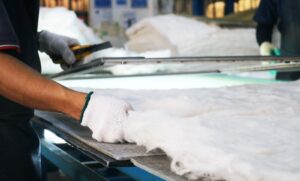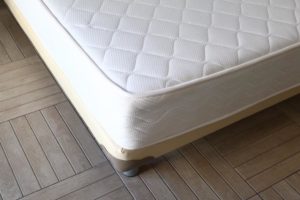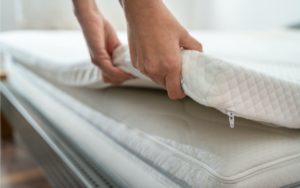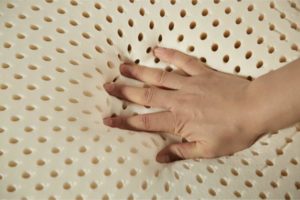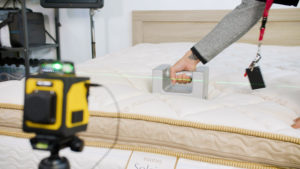Foam vs. Spring Mattresses: Major Differences and How to Choose
Shopping for a new mattress can be a confusing process. With hundreds of beds to choose from across dozens of categories, it can start to feel overwhelming. Fortunately, you can narrow down your search easily by focusing on one big question: Do you want a foam or an innerspring mattress?
We’ll focus on the differences between foam versus spring mattresses. By learning more about these two categories, you can become better informed when it comes to choosing the right mattress for your needs.
Foam Mattresses
| Description | Pros | Cons |
|---|---|---|
| All-foam construction, typically using a blend of memory foam, polyurethane foam, and other materials. Available in almost every price range, from $300 to over $3,000. |
|
|
Spring Mattresses
| Description | Pros | Cons |
|---|---|---|
| Made with metal springs or coils, which provide underlying support, as well as thin layers of foam. Available in most price ranges, typically from $300 to $1,500+ |
|
|
What’s the difference between a memory foam vs spring mattress? It all comes down to the materials used and the style of construction. The details of each style are discussed in later sections.
Which is better? There’s no definitive answer to that question.
Of the two mattress types, innerspring beds are the older and more “traditional” option. Some may think of them as old-fashioned, but there are plenty of high quality, comfortable, and modern spring mattresses available.
Foam mattresses are a newer concept, but exceptionally popular. While memory foam was originally invented in the 1960s, the foams used today are far more advanced. Manufacturers now create specialty foams designed for specific applications – cooling, support, pressure relief – and combine them to develop well-rounded mattresses.
When comparing foam vs spring mattresses, there’s no clear “best” or “worst” option. There are simply too many variables to consider to make a generalized claim that one is better than the other.
Rather, it is better to frame the question as a matter of which one is the better choice for you and your needs. Each type of mattress tends to perform better in certain ways, making them generally better suited to the needs of different kinds of sleepers. There is also plenty of variation in performance among models of the same type, making it important to investigate how a mattress is constructed.
Let us help you find the perfect bed
Answer a few questions to find the right mattress for your unique needs
What is a Foam Mattress?
Foam mattresses are all-foam beds that are exceptionally popular for online mattress shoppers. They can be made out of a variety of foam materials, from memory foam to polyfoam, and typically contain several unique layers. Foam beds can be soft or firm, budget or luxury, so there is a huge amount of variety within this category.
Foam beds utilize a variety of materials to provide support and pressure relief. There are many types of foams, and often manufacturers will utilize several materials in each mattress.
Types of Foam
Polyurethane (Poly) Foam – Foam made from polyurethane, commonly referred to as simply “polyfoam,” is a very common ingredient in modern foam beds. Polyfoam is known to be much more bouncy and springy than materials like memory foam. Polyfoam is popular for use as a layer in modern all-foam mattresses, as well as for the top comfort layer in spring beds.
- Regular polyfoam is a standard, relatively soft foam used primarily in transition layers.
- High-density polyfoam is firmer and often used in underlying support layers.
- High-resiliency polyfoam is firmer and more supportive, but significantly more expensive, so its use is less common.
Memory Foam – Memory foam is another very commonly used foam material. It’s made from similar polyurethane materials, with added ingredients to increase its density and viscosity. Memory foam is great for pressure relief, as it contours to the shape of the body. The term “memory” in memory foam refers to the material’s tendency to retain the shape of the body for a few seconds after being indented.
- Standard memory foam is the traditional material that’s soft yet supportive, and generally affordable.
- Open-cell memory foam is designed with openings in the tiny cells of foam, allowing for better airflow. This material feels a bit softer, and it will sleep cooler on warm nights.
- Gel memory foam has tiny gel beads embedded into the memory foam material. The gel, combined with the open-cell design, helps to improve cooling and airflow.
Latex Foam – Latex is a natural rubber-like material that can be used to make a durable and bouncy foam. Latex mattresses are typically considered a category of their own, but some manufacturers also use a thin layer of latex in all-foam beds. Latex is often prized for its durability and environmental friendliness, although it is generally much more expensive than traditional polyurethane-based foams.
- Dunlop latex is made using a more traditional, simple process, and results in a somewhat firmer feel.
- Talalay latex foam is a more energy-intensive process that produces latex with a bouncier, yet softer feel.
Remember that most mattress manufacturers use a mix of different foam materials to create a well-balanced and comfortable bed. Typically you will see foam mattresses constructed of 2-5 layers, each with varying materials, densities, and intended purposes. When it comes to budget mattresses, you may see single-layer polyfoam beds – but otherwise, expect a blend of foam layers in most modern mattresses.

What is a Spring Mattress?
Spring mattresses, also called innerspring mattresses, are beds that utilize dozens to hundreds of metal springs to provide an underlying support layer. They also have softer plush material layers to increase comfort. Some find that spring mattresses feel more supportive than foam, at least initially. This is particularly true for heavier people, who may benefit more from the coiled spring support systems than a foam base.
Several factors can influence how a spring bed feels. Coil count is an important factor; most quality beds will have around 400 coils or more in a queen size mattress. However, keep in mind that a higher coil count does not necessarily equal a higher quality bed, as there are many factors at play.
Spring beds will also often have foam layers surrounding the coils, as well as a plush or polyfoam comfort layer on top. The quality, material, and thickness of these layers can greatly influence the comfort and feel of the mattress.
Coil gauge, referring to the thickness of the wire used, influences the firmness of the bed. Manufacturers will clearly list the intended firmness of each mattress model, so checking the coil gauge is not too important for consumers.
Lastly, the various types of springs used in these mattresses will impact their comfort and support ratings.
Types of Springs/Coils
Bonnell Coils – Bonnell coils are the original design used in the first spring mattresses, and some manufacturers still use them today. They are hourglass-shaped and can be made to be either soft or firm depending on the wire gauge. Bonnell coils are simple and cost-effective, so many mattresses utilize them.
Pocket Coils – Also called pocketed coils, this design features metal coils that are individually wrapped in fabric sleeves. This allows each coil to move independently from one another, which has the added effect of reducing noise. Pocketed coils are often used in higher-end beds, and are generally more expensive to make. They do a great job of providing targeted pressure relief, and tend to provide a more buoyant feel overall.
Offset Coils – Offset coils share some properties of pocket coils, but they are joined together with hinged wires. This allows the coils to flex under soft pressure, but provide firm support when it’s needed. Offset coils can provide more firmness than pocketed coils, so many innerspring beds with higher firmness ratings over 7 out of 10 will use some form of offset coil. Beyond this application, offset coils are not commonly used.
Continuous Coils – Continuous coil design features a single wire that is used to construct an entire row of “coils”. Each of these rows is then attached to each other using helical wires. This design provides a very firm support system, but because each component is joined together, continuous coils have much less ability to shape themselves to a body profile.
Which is Better for You?
Ultimately, choosing the right bed for you involves a lot more than just picking between foam and spring. There are high quality, comfortable and supportive mattresses of both types available – so in the end, it’s more about picking the right mattress model.
With that said, there are a few last things to consider.
Most people will be happy with a high-quality foam mattress. Foam provides a great middle-ground by offering a supportive and pressure-relieving fit, while also feeling soft and comfortable. Side sleepers, in particular, tend to prefer foam beds, as they often do a better job of conforming to the shape of the body.
People who tend to sleep hot at night may wish to opt for a spring mattress. Innerspring beds offer far better airflow, which helps to keep the bed cool at night.
Sleepers who are heavy or sleep on their stomachs should opt for either innerspring, hybrid, or very firm foam beds, in order to get enough support. Softer foam models will likely sink too much to feel comfortable for these sleepers.
Most online mattress retailers now offer free trial periods, where you can test the bed for up to several months. If you’re unsure about a mattress, this flexibility may provide a little reassurance during the purchase process.

Still have questions? Ask our community!
Join our Sleep Care Community — a trusted hub of sleep health professionals, product specialists, and people just like you. Whether you need expert sleep advice for your insomnia or you’re searching for the perfect mattress, we’ve got you covered. Get personalized guidance from the experts who know sleep best.






